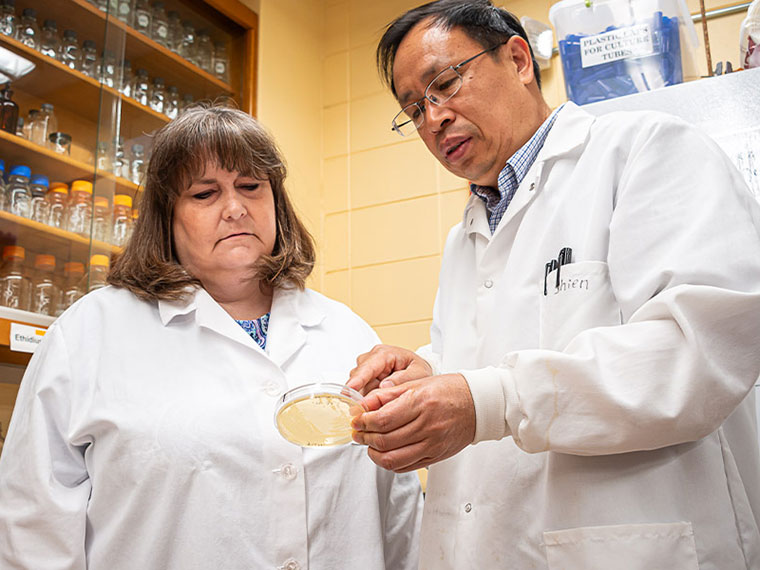The information presented on this page may be dated. It may refer to situations which have changed or people who are no longer affiliated with the university. It is archived as part of Mississippi State University's history.
From lichens, yeast, rust, and mold to the button mushrooms on your salad, there are 150,000 classified types of fungi that live on our planet. While some types of fungi can cure disease, like the mold that produces penicillium, others can cause ailments such as athlete's foot and life-threatening illnesses such as meningitis. Antifungal medications treat these conditions, but when patients are treated with the same drugs for recurring infections, fungal pathogens often become drug resistant. Developing new pharmaceuticals, therefore, is critical to ridding the body of harmful fungi.
Dr. Shien Lu, MAFES scientist and professor of plant bacteriology in the Department of Biochemistry, Molecular Biology, Entomology, and Plant Pathology, has been studying a new and powerful antifungal compound-occidiofungin-since 2009 in pursuit of its development for pharmaceutical use.
This year, the Federal Food and Drug Administration (FDA) approved Phase 1 trials for the drug Occidiofungin (OCF001) intravaginal gel, developed by Lu and his partners at Sano Chemicals0-a university spinout company-as a treatment for recurring vulvovaginal candidiasis, more commonly known as a yeast infection. "This is a big milestone because it takes many years to develop a pharmaceutical drug," said Lu. "Although we still have a lot of work ahead of us, getting FDA approval to pursue the drug's safety and effectiveness is a major achievement." Lu first came across this powerful antifungal almost by chance when he noticed a patch of green grass surrounded by a larger patch of brown grass and wondered what allowed that smaller patch to remain healthy. Taking a sample back to his lab, he found that the diseased grasses were infected by the pathogenic fungus Rhizoctonia solani. He also detected the bacterial strain MS14-which produces occidiofungin-in the root system of the healthy grass. Joining former Department of Biological Sciences researcher Dr. Leif Smith, now at Texas A&M University, and MSU College of Veterinary Medicine researchers Dr. Frank Austin and Dr. Stephen Pruett, Lu found his research taking an unexpected turn.
"Originally, I planned to use occidiofungin to develop a pesticide for agriculture, but my colleagues found that the pathogens living in humans and animals are more sensitive to the compound than those living in plants," he said.
Lu explained that occidiofungin works differently than other antifungals that treat yeast infections. The drug's mode of action-changes that it creates at the molecular level-works through apoptosis-sometimes referred to as programmed cell death.
"Most antifungal drugs only suppress the pathogen, but this one appears to kill it," he said. "It's important to continue developing new drugs that work on the body in different ways, so we have multiple means of fighting these infections." Occidiofungin's potential does not end here. The compound's particular mode of action also makes it a good candidate for treating severe fungal infections in immunocompromised patients and for fighting cancer-paths that Sano Chemicals is exploring. And although occidiofungin has the capability to fight disease in plants as well as humans and animals, Lu explained that pursuing both paths of development is not recommended.
"If you were to spray the compound into agricultural systems throughout the world, its widespread use would expedite the process of drug resistance in humans," he said. "Another factor is cost. Because we use an artificially synthesized version of the antifungal, it is expensive to produce, and we must decide how best to use those resources."
While Sano Chemicals begins the multi-phase FDA approval process, Lu and his colleagues continue their work in the lab, examining new strains of bacteria-based compounds that may lead to the discovery of future pharmaceuticals or bio-based pesticides.
"I'm very proud of my team and the work we've done to make it to this point," he said. "We are committed to continuing the work of discovering solutions for both human health and the health of our agricultural systems.
This project is funded by the Mississippi Agricultural and Forestry Experiment Station Strategic Research Initiative grant. This technology is licensed to the university spinout company Sano Chemicals. More information is available at www.sanochemicals.com.
Most Antifungal Drugs Only Suppress The Pathogen, But This One Appears To Kill It. It'S Important To Continue Developing New Drugs That Work On The Body In Different Ways, So We Have Multiple Means Of Fighting These Infections.
Dr. Shien Lu
Behind the Science

Shien Lu
Professor
Education: B.S., M.S., Plant Pathology, Shandong Agricultural University; Ph.D., Plant Pathology, Washington State University
Years At MSU: 19
Focus: Plant bacteriology
Passion At Work: Deciphering mechanisms of antimicrobial activities of bacteria to develop biopesticides and pharmaceutical drugs.

